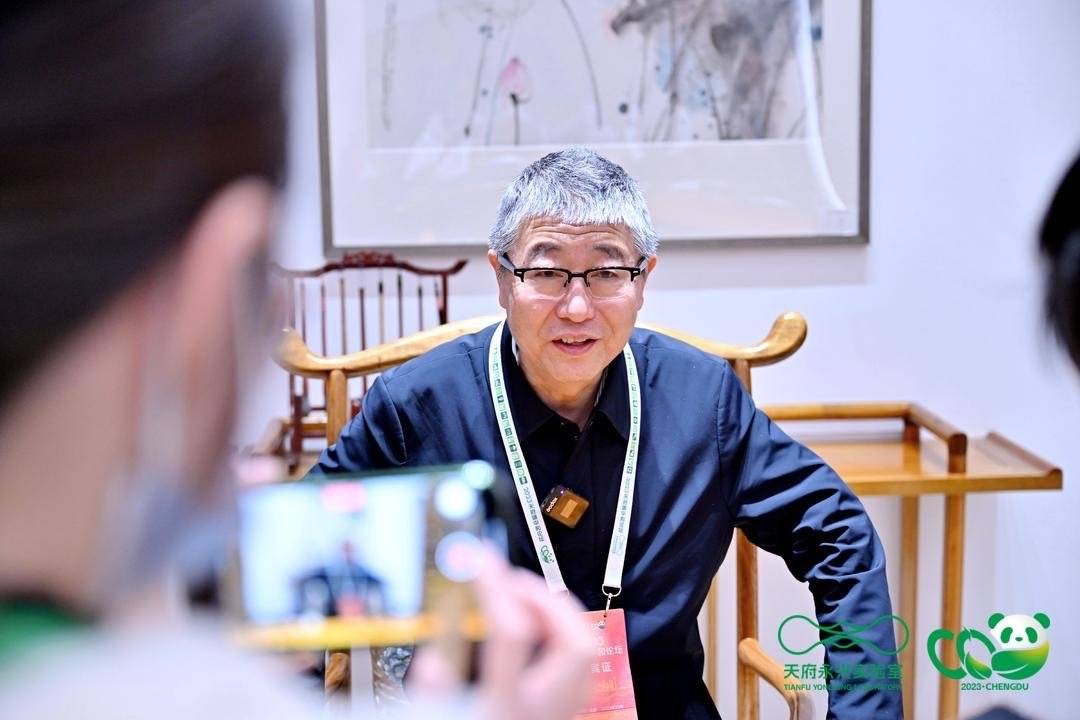Why Does the “Energy Revolution” Aiming to Reduce Carbon Emissions Start from Rural Areas? Academician Jiang Yi Shares His Assertion
Release Date:2023-12-27
On December 24th, the 2023 Tianfu Carbon Neutrality Forum, with the theme of “Promoting Technology and Industrial Conversion Simultaneously, Assisting High-Quality Development of Green Industries”, took place at the Tianfu International Convention Center in Chengdu. Hosted by Tianfu Yongxing Laboratory, with one main forum and seven parallel sub-forums, the Forum extended invitations to 22 academicians, over a hundred experts, scholars, and business representatives to discuss the development pathway of deep integration between technological innovation and industries from the perspective of green development.
During the keynote presentation session of the Forum, Jiang Yi, an academician of the Chinese Academy of Engineering, a member of the Academic Committee of Tianfu Yongxing Laboratory, and a professor of Tsinghua University, delivered a speech entitled “Low Carbon Pathway of Urban and Rural Energy Supply System”. He also engaged with reporters during the Forum breaks, giving suggestions and opinions on topics including promoting low-carbon development and zero-carbon buildings in rural Sichuan.

How to achieve low-carbon transformation of the urban and rural energy supply system?
At the keynote speech of the Forum, Jiang Yi shared one of the outcomes of the major project of the Chinese Academy of Engineering this year: low-carbon pathway of the urban and rural energy supply system. According to Jiang Yi, the urban and rural energy supply system encompasses power supply, heat supply, and fuel supply, and currently about over 70% of the carbon emissions of the whole society were generated in various parts of this system.
How to reduce carbon emissions in the urban and rural energy supply system and complete its low-carbon transformation? That requires an energy revolution aimed at changing the energy mix, which is to transform the current carbon-based energy system consisting of coal, gas, and oil into a new zero-carbon energy system composed of wind energy, solar energy, hydroenergy, nuclear energy, and biomass fuels.
To achieve this energy revolution, multiple main tasks need to be promoted, including comprehensive electrification of terminal energy, the development of a new power system mainly consisting of wind and solar power both intensively and separately, and full utilization of the waste heat generated by human activities to establish a new zero-carbon thermal system based on heat pump technology. This will help minimize dependence on fuel and establish a new fuel supply system based on biomass commercial fuels and green hydrogen synthesis.
In addition, Jiang Yi stated that the energy revolution started in rural areas and gradually expanded to urban areas. “Biomass fuels exist in rural areas and the key areas of distributed photovoltaic utilization are rural areas as well. Photovoltaics can meet the energy needs of rural areas, and the extra biomass resources can be processed into commercial fuels to serve as the main zero-carbon fuels in the future. Through comprehensive electrification, rural revitalization can be achieved. The reform of the entire power system is complex, and it is relatively simple to start from rural areas. Therefore, it is recommended to initiate the process with indoor direct-current microgrids and village-level direct-current microgrids and promote them to counties step by step, enabling a step-by-step transformation of the power system.”
Western Sichuan should be a key area for developing and utilizing new zero-carbon energy
In recent years, Jiang Yi’s team has found that rural villages in the northern and eastern China have abundant ‘roof resources’ and good sunlight when conducting surveys and research on these rural areas. By installing photovoltaic panels on the exterior surfaces of various buildings represented by rooftops in these villages, sufficient electricity was obtained through solar energy. At present, these photovoltaic power generation can not only meet the electricity needs of rural life, production, and transportation, but also provide surplus electricity to the State Grid, becoming a new economic income source for agricultural, pastoral, and forestry areas.
“Western Sichuan, with abundant sunlight, is one of the areas with high solar radiation intensity in China. Therefore, I think it is very meaningful for Sichuan to develop this ‘key area’.” Jiang Yi replied when asked about the foundations of rural Sichuan in promoting low-carbon initiatives in the interview during the Forum breaks.
Jiang Yi also mentioned that western Sichuan had not only abundant sunshine and spatial resources, but also small hydropower stations and wind power resources, making it an ideal location for zero-carbon resources gathering. “Therefore, (western Sichuan) should be a key area for the development and utilization of new zero-carbon energy.” said Jiang Yi.
In addition, Jiang Yi believes that the realization of comprehensive electrification in western Sichuan by using rooftop photovoltaics, small hydropower stations, and distributed wind power as all energy sources in this region can not only preserve the fragile grassland ecological environment by completely eliminating the use of fossil fuel in the region, but also reduce energy costs in the region.
Meanwhile, sufficient electricity allows residents in western Sichuan to no longer burn biomass materials such as straw, firewood, cow manure, and sheep manure in their daily lives. Instead, these residents process these fuels into biomass zero-carbon fuels such as pellet fuel, block fuel, biogas, and biofuel, and sell these fuels in the commodity fuel market, providing zero-carbon fuels for the country.
Quick questions and answers
In the interview, the reporter interviewed Jiang Yi on topics such as the development of technology system of China’s zero-carbon energy system and the progress and implementation difficulties of zero-carbon buildings.
Reporter: What is the current state of the development of the technology system of China’s zero-carbon energy system?
Jiang Yi: At present, the route of related technologies has been understood, but we still need to proceed cautiously. For example, as mentioned in my report, the wind and photovoltaic power capacity needs to be increased by 10 times.
Reporter: You mentioned our research center for zero-carbon buildings. Can you tell us about the current progress in the development of zero-carbon buildings in our country?
Jiang Yi: What is the biggest difference between zero-carbon buildings and previous energy-saving and low-energy consumption buildings? Firstly, they are both energy-saving and low-energy consumption; secondly, the new requirement of zero-carbon buildings is to achieve complete electrification, eliminating the use of all fuels; thirdly, the building surface space of zero-carbon buildings can be fully utilized to install solar photovoltaic panels for self-electricity production; fourthly, zero-carbon buildings are required to have a certain energy storage capacity, to flexibly absorb their own solar photovoltaic energy, and to selectively absorb and store wind and photovoltaic power from the external grid. Therefore, in terms of electricity flexibility, energy storage, and power generation, zero-carbon buildings are different from previous energy-efficient buildings for they’ve developed further.
Reporter: Are there any difficulties in the implementation of such zero-carbon buildings at present?
Jiang Yi: The current difficulties are closely related to policy mechanisms, which is the policy mechanisms of the power system. The way zero-carbon buildings interact with the power grid depends on the policy mechanisms and pricing policies of the power system. Only by creating a favorable external environment can the development of zero-carbon buildings be advanced.
Reporter: The burgeoning technology, artificial intelligence (AI), is applied in various research in many disciplines nowadays. Can AI technology contribute to the low-carbon development of the energy supply system?
Jiang Yi: AI can enhance its implementation, but is not the most fundamental element. The cornerstone lies in the hardware architecture. Only when the relevant hardware systems are refined can software technologies including artificial intelligence prove beneficial.
[ By Tan Yuqing, Yan Wenwen from the Cover News ]
 Tel
Tel Postal
Postal Address
Address